Drawing Mohr Circle by Pole Method
Intro and Derivation
Mohr'southward circle is a geometric representation of plane (2nd) stress transformation and allows united states to quickly visualize how the normal (σ) and shear (τ) stress components change as their plane changes orientation.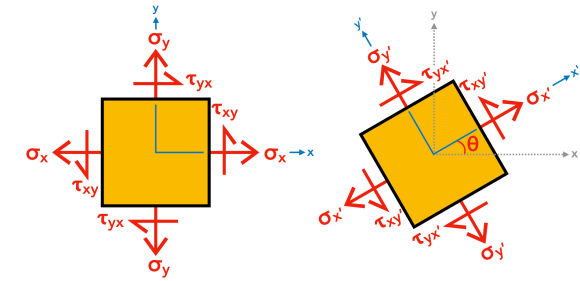 German civil engineer Otto Mohr developed this method from the good ol' stress transformation equations. Recall:
German civil engineer Otto Mohr developed this method from the good ol' stress transformation equations. Recall: If we remove θ by squaring both sides of each equation and and then add the 2 equations together, we go:
If we remove θ by squaring both sides of each equation and and then add the 2 equations together, we go:
![]() After defining σavg and R, we can alter Equation 3 to get Equation four, which is the equation for a circle with center (σavg,0) and radius R.
After defining σavg and R, we can alter Equation 3 to get Equation four, which is the equation for a circle with center (σavg,0) and radius R.

Sign Convention
The sign convention for normal stress (σ) is that tension is positive and pinch is negative . Shear stress (τ) is illustrated below. Geotechnical engineers may employ the opposite sign conventions, because they mostly deal with compressive stress.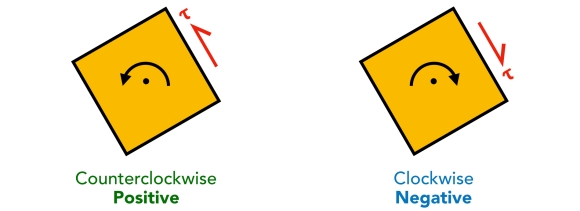 Mohr's circle is drawn with normal stress (σ) plotted on the abscissa (horizontal axis) and shear stress (τ) plotted on the ordinate (vertical centrality). Normal stress (σ) is positive to the right, and shear stress (τ) is positive downward.
Mohr's circle is drawn with normal stress (σ) plotted on the abscissa (horizontal axis) and shear stress (τ) plotted on the ordinate (vertical centrality). Normal stress (σ) is positive to the right, and shear stress (τ) is positive downward.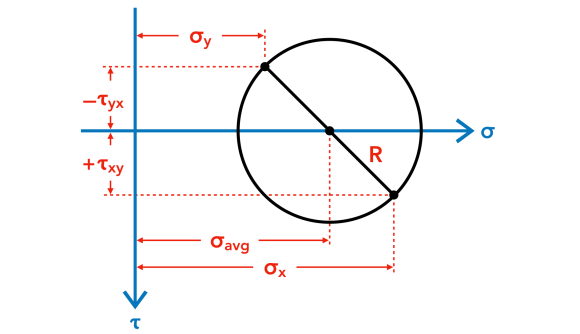
Pole Method
Most mechanics of materials textbooks prefer using the Double Angle Method to draw Mohr'southward circles. The general thought of this approach is that angles between radial lines in the Mohr'south circle are twice the bodily angles between the real planes. In other words, a 40° rotation on the plane corresponds to an eighty° rotation on the circle in the same management.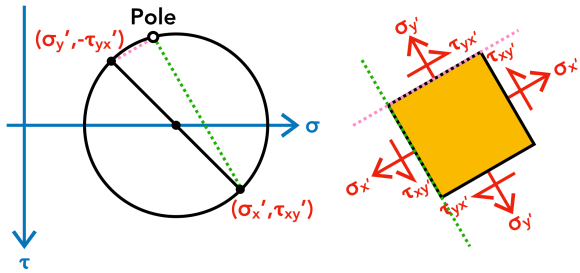 We adopt thePole Method, which is based on a unique point on the Mohr's circle known as thepole. This pole is unique, because any directly line drawn through the pole intersects the Mohr'south circumvolve at a point representing the state of stress on a aeroplane with the same orientation equally the line. Every bit shown in the figure above, a line fatigued through the pole and some stress betoken (σ,𝜏) on the circumvolve isexactly parallel to the plane with respective σ and 𝜏, making this approach very intuitive! Let the states illustrate how the pole method works.
We adopt thePole Method, which is based on a unique point on the Mohr's circle known as thepole. This pole is unique, because any directly line drawn through the pole intersects the Mohr'south circumvolve at a point representing the state of stress on a aeroplane with the same orientation equally the line. Every bit shown in the figure above, a line fatigued through the pole and some stress betoken (σ,𝜏) on the circumvolve isexactly parallel to the plane with respective σ and 𝜏, making this approach very intuitive! Let the states illustrate how the pole method works.
To draw a Mohr'southward circle, we need to know the plane land of stresses for an chemical element. Consider this: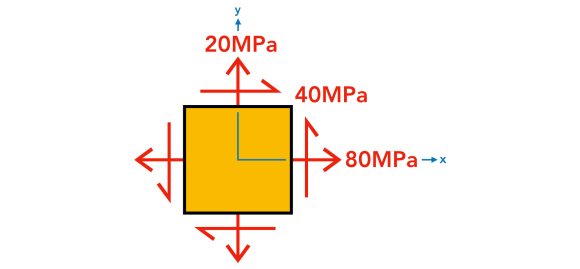 ane. Plot the Stresses
ane. Plot the Stresses
Immediately, we know the two points that form the bore of the circle, (σx,𝜏xy) = (80,40) and (σy,𝜏yx) = (20,-40). (If you lot are asking why 𝜏yx is -40, remember the sign convention for shear stress!) The eye of the circle is the halfway point between σ10 and σy, or σavg.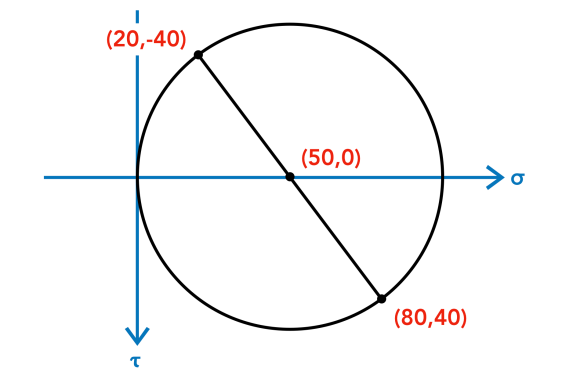 two. Locate the Pole
two. Locate the Pole
Draw a straight line from ane of the known stress points on the circle (σ,τ) in the direction of the plane on which (σ,τ) acts. Starting at indicate (80,40), a line is fatigued parallel to the plane on which (80,xl) acts. This is represented by the vertical dotted light-green line in the figure below. Starting at point (20,-40), a second line is drawn parallel to the plane on which (xx,-xl) acts. This is represented by the horizontal dotted pink line in the aforementioned figure below. The pole is at the intersection of these dotted lines on the circle. Note that in that location is but I pole!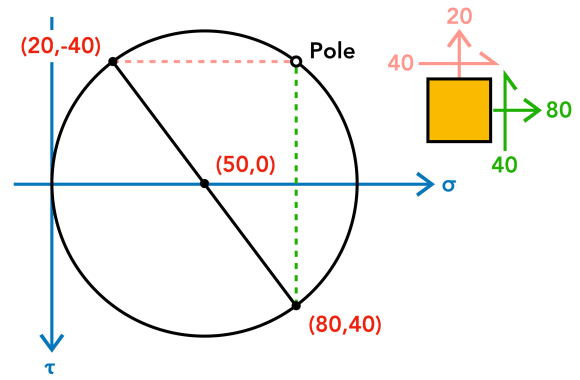
3. Find Transformed Stresses (e.thou. 30° CCW Rotation)
To find other states of stresses, we start drawing the lines from the pole instead of a known stress point (σ,τ). This is the general procedure:
- Draw a line from the pole in the direction of orientation of the transformed plane.
- The point where this line intersects the circle represents the state of stress acting on that plane.
Let usa assume a thirty° counterclockwise (CCW) rotation of the chemical element. Starting at the pole, to find the transformed counterpart of (20,-forty), we draw a new line that is 30° CCW from the existing dotted pinkish line. The transformed stresses on this airplane is where the new pink line intersects the circle. Similarly, to detect the transformed counterpart of (80,40), we draw a new line from the pole that is 30° CCW from the existing dotted greenish line. The transformed stresses on this airplane is where the new light-green line intersects the circle. Staying consequent with the rules, the new lines are parallel to their respective planes. The transformed stresses are:
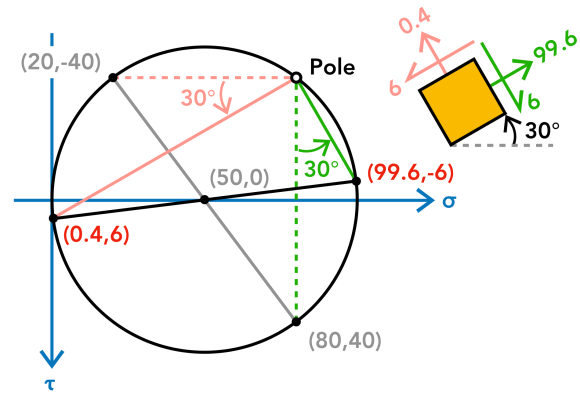
To become these transformed stress values past hand, nosotros would need a protractor to measure the angle and a ruler to connect the pole to the indicate of intersection on the circumvolve. This tin can seem like an elaborate process, and it goes to show that hand-computing plane stress transformations via Mohr's circle is only an approximate method. To get the exact transformed stress values, we tin use the good ol' stress transformation equations.
4. Cheque with Analytical Method
Using the the stress transformation equations (Equations 1 and 2):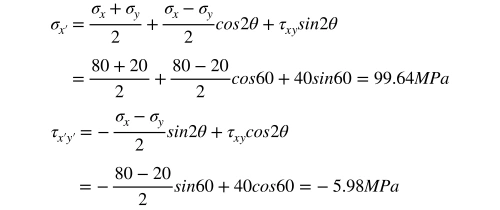 Because the center of the circle, or σavg, is the same (the circumvolve does NOT movement!), we can notice σy'.
Because the center of the circle, or σavg, is the same (the circumvolve does NOT movement!), we can notice σy'.![]() 5. Primary Stresses
5. Primary Stresses
Principal stresses act on planes where τ = 0. The larger principal stress is chosen themajor principal stress, and the smaller principal stress is chosen themodest principal stress.
Similar to finding transformed stresses, we draw lines from the pole to where τ = 0, or the 2 "10-intercepts" on the circle. The major and modest principal stresses are 100MPa and 0MPa, respectively. The angle, or the rotation required to reach zero shear stress on the plane, is measured between either pair of the original (dotted) line and the new line connecting the pole to the "x-intercept".
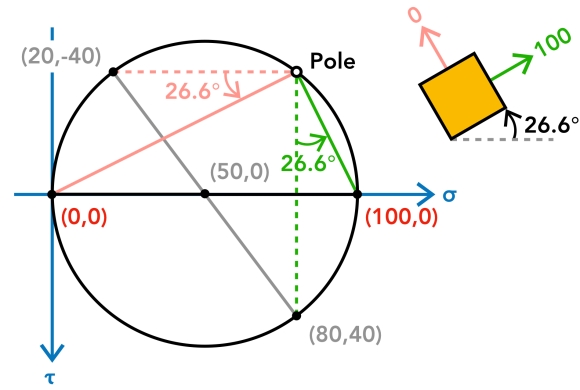
Square vs. Triangle
Some textbooks show stress elements as squares (like in this article), while others show them as triangles. They are two different representations of the same element, because the triangles are just corner cutouts from the square, as shown below by the two a-a and b-b sections.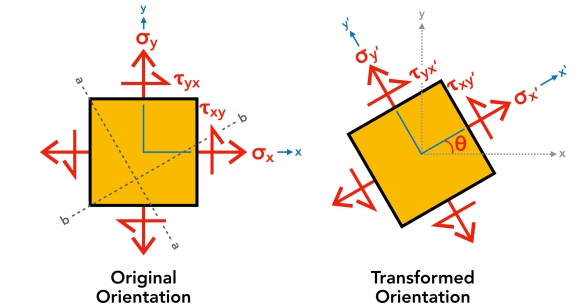 The advantage of the triangular representation is that we can visually identify the transformed stresses on the hypotenuse. However, since we are dealing with two transformed normal stresses (σ10' and σy'), nosotros still need two triangles to give complete representation of plane stresses. In the effigy below, ΔA is the sectioned area (length of hypotenuse × depth of 3D stress block).
The advantage of the triangular representation is that we can visually identify the transformed stresses on the hypotenuse. However, since we are dealing with two transformed normal stresses (σ10' and σy'), nosotros still need two triangles to give complete representation of plane stresses. In the effigy below, ΔA is the sectioned area (length of hypotenuse × depth of 3D stress block).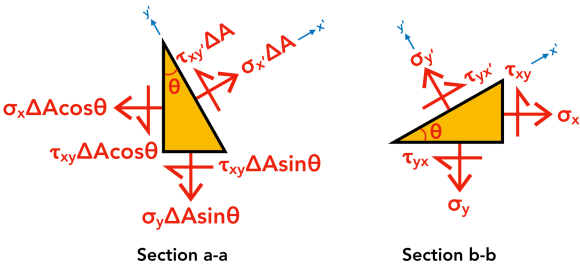
TL;DR
- Stresses change every bit the plane on which they human action changes orientation. Mohr'south circumvolve "maps" these changes.
- Keeping a consistent sign convention is important.
- In Pole Method, things are adamant in this order: (σ,τ) → pole → (σ',τ').
- To determine whatever transformed aeroplane state of stress (σ',τ'), nosotros ALWAYS get-go at the pole and draw a line parallel to the plane. The signal of intersection on the circle is (σ',τ').
Source: https://structnotes.com/2018/06/23/mohrs-circle/
0 Response to "Drawing Mohr Circle by Pole Method"
Post a Comment